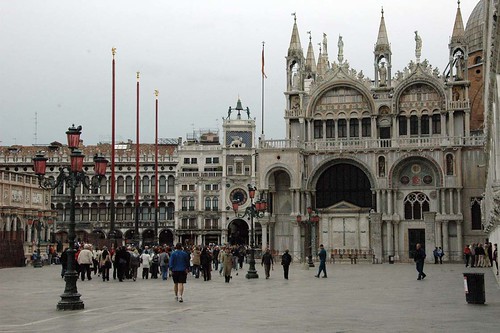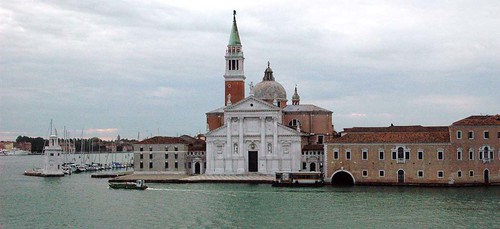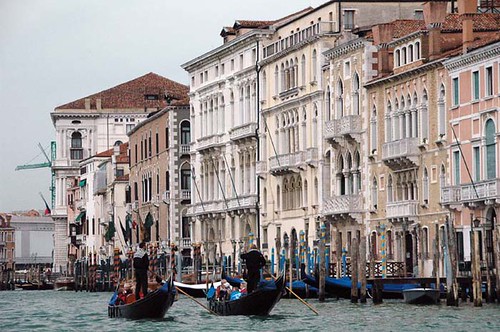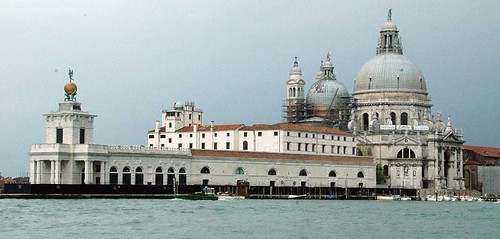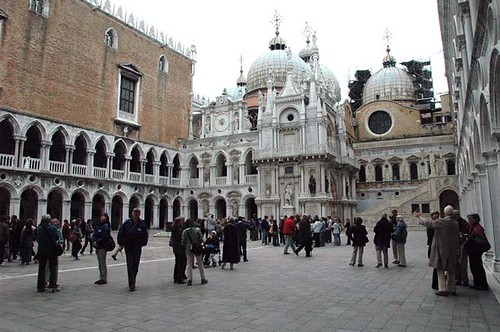Sunday, April 19
Venice, ItalyThere are several ways to reach Venice: trains, planes, buses, bicycles, cars. But from the sea is the best. When you slip through the Lido inlet, the Isola Le Vignole is just off starboard. Bearing to port, you leave the Isola di Sant Elena to starboard as well – Venice is a city of a hundred islands – and head for the basin of St. Marco at the confluence of the Grand Canal, the Guidecca Canal, and the Canal of San Marco. If you thought seeing Venice after seeing its after-images in Dubrovnik, Korcula, and Kotor would render the experience déjà vu, you are pleasantly mistaken.
A city that literally rises up out of the sea takes some getting used to. My experience of islands is of land surrounded by sand surrounded by water. Lots of trees and hills are on my islands. Take Cuttyhunk, for example. That is a typical island for me. Venice couldn’t be farther away from Cuttyhunk were it on Mars.
For one thing the buildings all rise straight up from the water’s edge. First, there is water. Then there is stone and the occasional tree. Its hills are the humps of bridges that span the canals. The waterways are as wide as half a mile, or else so narrow you can jump them. At rush hour the canals float hundreds of boats filled with people, produce, or trash. Water constantly assaults the sides of the canals. The sound of slapping wake is everywhere.
Venice has no cars, no mopeds, no motorcycles, no bicycles. You either walk or ride on water. Consequently the sloshing of waves or, away from the water, the murmur of conversation provides an incessant basso ostinato to the music of the city. Occasionally bells tolling the hour or calling the faithful to church punctuate both.
As the Island Sky makes its slow way into the Giudecca Canal, we pass San Giovanni Maggiore on our port side. Built by Andrea Palladio in 1559-80, it dominates its own little island. Once a home to Benedictine monks, the monastery is now a cultural center. The facade of the Church is orderly. If anything it resembles the coffin ends typical of graves in an Italian cemetery.
Inside, in what is called the Chapel of the Dead, is Tintoretto’s last painting. It had to be finished by his son, Domenico. The painting, The Deposition, depicts Christ being taken down from the cross. The slant and tilt of his body recalls Michaelangelo’s Pietà.
It is hard to get away from death in Venice. To starboard we pass the incredible Santa Maria della Salute, a massive stone church whose bulk ought to have sunk the entire island. The church was begun in the year 1630 by Baldassare Longhena to give thanks for the end of the bubonic plague in that same year, a plague that took 100,000 Venetians – over half the islands’ population, Titian among them. Longhena died in 1682 at the age of 84. The church was completed five years after his death.
The broad walk that follows the Guidecca Canal as we glide toward our berth is called the Zattere. The name, which means raft or pontoon, may have come from the days when the street was used as a docking place for barges loaded with cargo. When Nancy and I first came to Venice about 12 years ago, we stayed in a pensione on the Zattere. As it drifts by, I remember the ancient British actor who took his evening meal there every night of his annual summer’s visit. He must have been in his eighties. His face was familiar to us.
That is how we started the conversation. He was nostalgic about England, spoke of his children who did not share his love of the city. He returned, so he said, every year like a lover to the graveside of a lover. He dressed for dinner every night, elegantly so, though there was no party to attend, no reception to adorn.
Venice is filled with such people. They will never stop coming back even after they are gone. The neighborhood is called the Dorsoduro. It literally means “hard backbone.” It draws its name from the compacted clay that lies beneath the swamp on which Venice was built in the 5th century when the Italians took refuge here to escape the Gothic onrush. The method of building is ingenious and, in fact, the John Hancock Building in Boston was raised in much the same way. Basically, pilings are driven through the swampy ground to the compacted clay beneath. Then buildings are erected on top of the pilings. To form the foundation for Santa Maria della Salute, over a million piles were driven into the Dorsoduro. Recently, the piles were inspected for soundness. Apparently, there wasn’t the slightest sign of decay.
As you walk through the streets of Venice, you see a number of plaques commemorating the visit of one artist or another and being here a long time does not seem to matter. One plaque tells us Goethe spent two weeks in this house, another that Mozart spent a pleasant festival week in that one. There is no dearth of famous people who have stayed here. Across from the Accademia is the Palazzo Barbaro where Whistler and Monet painted and Henry James wrote “The Aspern Papers.” The award for the longest stay has to go to Ezra Pound, who is buried on the cemetery island of St. Michelle. Ezra Pound’s grave in the Evangelisti or Protestant section of the cemetery is a simple one, a small headstone, its face slightly tilted upward at a 45-degree angle toward the visitor. The name is all that is engraved on it.
One day in Venice is like a pop-up picture book to the real thing. I am glad I was here 12 years ago with the leisure and the energy to take it all in. And, in any case, I’m never very far from Venice. There is a video camera that broadcasts an image of the Piazza San Marco 24 hours a day. I have had it up and running on my computer for several years now.
Venice is just a keyboard click away. In fact, I’m looking at San Marco now, as I write these final words.
